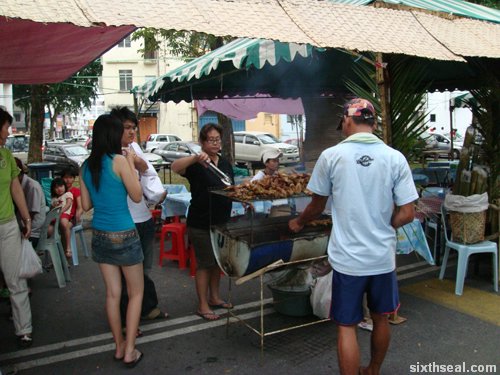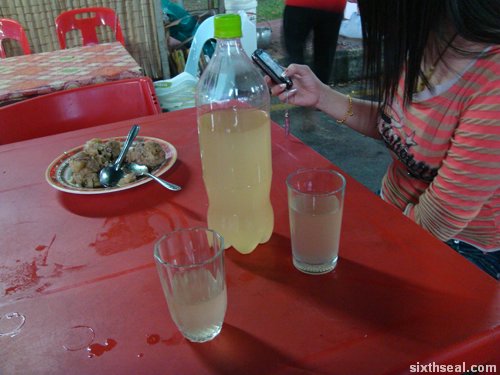
The BCF 2008 ended the Borneo Dayak Festival (BDF) with a tuak (local Iban rice wine) drinking competition, a finale highly (no pun intended) befitting the Dayak themed festival. The Dayak is a collective reference to a local ethnic group comprising of several subgroups of which the majority is Iban.

The Borneo Dayak Festival is centralized around a long row of food stalls bordering the BCF 2008 perimeter grounds. The food stalls offer a large variety of local delights including pansoh manok (bamboo cooked meat) and tuak.

There are also stalls showcasing the native art of the Dayaks with their knitted tribal designs being the most popular.

The shapely legs of the locals are also on display in certain stalls, though I suspect it’s not for sale. 😉

There are also a lot of stalls catering to the thirst of the crowd with local mixed drinks like air bandong (a popular concoction of rose syrup and evaporated milk), air jagung (corn drink, tastes better than it sounds) and coconut juice.

I came across a stall selling fresh sugarcane juice. Fresh sugarcane is made by using a pressure roller machine to extract the negligible moisture content from a sugarcane plant. It takes a lot of plants to make a single cup of the juice.

The sugarcane is first peeled and then inserted into this medieval looking machine with a hose that directs the juice down into a filter.

Careful Pakcik! The rollers are not friendly to human fingers! 😉

I would be remiss if I didn’t eat the pansoh manok (meat cooked in bamboo). It’s a local Iban delicacy where the meat is stuffed inside hollow bamboo plants and then cooked slowly over a charcoal fire.

It is then unsealed by taking out the leaves stuffing one end and emptying the contents into a plate. There are plastic seating arrangements at the BCF 2008 for the food stalls.

Of course, a meal of pansoh manok would be incomplete without the obligatory tuak (Iban rice wine). Tuak is made from fermented rice and it’s sold in 1.25 liter PET bottles that once contained 7Up or Coke for RM 10. 😉

We had the pork pansoh manok (RM 15). There are three different types of pansoh manok in this stall – pork, chicken and fish.

I was a little inebriated after drinking the 1.25 litre bottle of tuak. Tuak can contain anything from 9 – 14 % alcohol. There’s really no control in the fermentation process and some tuak is “fortified” with cheap distilled liquor for more oomph…

In fact, I was more than a little inebriated from the tuak. I went and played some carnival games after that and a video was taken of me that projects me in a less than complimentary light. More on that carnival games tomorrow – I’m going again tonight. 🙂

Borneo Cultural Festival 2008 is a week long annual event at Swan City (Sibu).
Sob…sob…it’s coming to an end, and I havent had any of the pansuh manok, babi, ikan…!!!! My life is so pathetic!!! How come when I was young and could eat anything I wanted, didn’t have all the nice things to eat? Kampua and kompia only!
HB,
actually, ‘pansoh manok’ refers to the ‘chicken cooked in bamboo’.
(pansoh – cooked in bamboo, manok – chicken)
pansoh babi – pork cooked in bamboo
and
pansoh ikan – fish cooked in bamboo.
Manok=chicken. There is no such thing as pork pansoh manok. I usually call it manok pansuh. I guess Chris Anakapai pretty much explained it already.
not tomorrow last day?
HB, I never try tuak before mind decribe in detail how its taste like and when do the rush (mabuk) kick in or how much a person can handle.
Dude, Pressed sugar cane are the best, beats Yeo’s packaged variety. When the sugar canes were pressed in public with a “Brigg and Stratton” petrol lawnmower two stroke engine. The engine smoke gives the sugar cane juice a mellow hint of Cuban Cigar and aged oak barrel finishing similar to fine Cognac or 15 years Single malt whiskey.
Enjoy yr weekend HB!
e: It’s looks more like a Honda single cylinder four stroke engine in the above pic.
HB, now I feel really jealous on the air tebu. Here, 1 stick of 10 cm sugar cane cost RM8. Very pale looking somemore. Jiak lak.
I grew up in Simunjan until 4 or 5. My dad knows many Ibans, he even speaks best in Iban. So, we used to have “free flow” of tuak and kueh jala during Gawai plus minus 1 month. Those old-day tuaks were unbeatable.
Tuak nyamai~~~
suituapui: Well, guess that would be the food your crave for. 🙂
I crave for Chinese food sometimes coz I was born eating the stuff. I do get cravings for fish and chips (like the ones from New Zealand/Australia) and this foot long hotdog I had back in NZ. Also this Chinese food place in Caulfield, Melbourne near the campus which has just about the best cheap Chinese food around. People crave for the strangest things.
Chris Anakapai: Oops…my mistake. The stall was selling all three kinds. I went again during the final day and sampled the fish and the chicken. Photos will be up soon.
Thanks for the correction! 🙂
Secret Admire: OMG! I didn’t know you knew so much about these things!
…and you claim not to be intelligent some more. :p
clementwpy: Yeah, yesterday was the last day. 🙂
Roland: Hmm…it’s kinda like wine. I consider it about the same proof as wine. It goes through a fermentation process that uses yeast as the catalyst. It’s kinda like beer in a sense but made with rice instead of barley/wheat. Some tuak is added with the Peng Guan cheap liquor to increase the alcohol content. It feels like just about any liquor out there. Tastes kinda sourish.
How much a person can handle depends on alcohol tolerance. For a daily drinker like me (oops, did I say that out loud?) I can drink quite a lot, while if you don’t drink frequently or have a genetic disposition which renders you unable to efficiently process alcohol, then you probably can’t drink a lot.
e: Yeah, it’s very old skool. I think it tastes better than Yeos too. I don’t know if it’s psychological but there seem to be too much artificial flavoring in Yeos.
goolooloo: Cheers Mary! 🙂
…and thanks for everything!
Jeff: Hmm…both of you must be engineers to notice details like that. 😉
fish fish: That is expensive! I though sugar cane is cultivated in some South American countries? I don’t ever see it planted over here, I don’t know where they get their neverending stock from. Must be somewhere in the jungle but I’ve never seen it before. On the other hand, I’ve seen palm oil estates, dragon fruit farms and others. I wonder where the sugar canes are planted over here.
the festival looks quite interesting. have just been there and find sarawak & sabah very unique 🙂